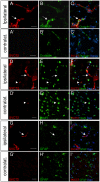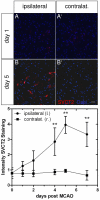Sodium-dependent vitamin C transporter 2 (SVCT2) expression and activity in brain capillary endothelial cells after transient ischemia in mice
- PMID: 21347255
- PMCID: PMC3037964
- DOI: 10.1371/journal.pone.0017139
Sodium-dependent vitamin C transporter 2 (SVCT2) expression and activity in brain capillary endothelial cells after transient ischemia in mice
Abstract
Expression and transport activity of Sodium-dependent Vitamin C Transporter 2 (SVCT2) was shown in various tissues and organs. Vitamin C was shown to be cerebroprotective in several animal models of stroke. Data on expression, localization and transport activity of SVCT2 after cerebral ischemia, however, has been scarce so far. Thus, we studied the expression of SVCT2 after middle cerebral artery occlusion (MCAO) in mice by immunohistochemistry. We found an upregulation of SVCT2 after stroke. Co-stainings with Occludin, Von-Willebrand Factor and CD34 demonstrated localization of SVCT2 in brain capillary endothelial cells in the ischemic area after stroke. Time-course analyses of SVCT2 expression by immunohistochemistry and western blots showed upregulation in the subacute phase of 2-5 days. Radioactive uptake assays using (14)C-labelled ascorbic acid showed a significant increase of ascorbic acid uptake into the brain after stroke. Taken together, these results provide evidence for the expression and transport activity of SVCT2 in brain capillary endothelial cells after transient ischemia in mice. These results may lead to the development of novel neuroprotective strategies in stroke therapy.
Conflict of interest statement
Figures





Similar articles
-
Orally administrated ascorbic acid suppresses neuronal damage and modifies expression of SVCT2 and GLUT1 in the brain of diabetic rats with cerebral ischemia-reperfusion.Nutrients. 2014 Apr 15;6(4):1554-77. doi: 10.3390/nu6041554. Nutrients. 2014. PMID: 24739976 Free PMC article.
-
Effect of middle cerebral artery occlusion on mRNA expression for the sodium-coupled vitamin C transporter SVCT2 in rat brain.J Neurochem. 2003 Aug;86(4):896-906. doi: 10.1046/j.1471-4159.2003.01891.x. J Neurochem. 2003. PMID: 12887688
-
Mitochondrial ascorbic acid transport is mediated by a low-affinity form of the sodium-coupled ascorbic acid transporter-2.Free Radic Biol Med. 2014 May;70:241-54. doi: 10.1016/j.freeradbiomed.2014.02.021. Epub 2014 Mar 2. Free Radic Biol Med. 2014. PMID: 24594434
-
The sodium-dependent ascorbic acid transporter family SLC23.Mol Aspects Med. 2013 Apr-Jun;34(2-3):436-54. doi: 10.1016/j.mam.2012.12.002. Mol Aspects Med. 2013. PMID: 23506882 Review.
-
Sodium-dependent ascorbic acid transporter family SLC23.Pflugers Arch. 2004 Feb;447(5):677-82. doi: 10.1007/s00424-003-1104-1. Epub 2003 Jul 4. Pflugers Arch. 2004. PMID: 12845532 Review.
Cited by
-
Food-derived hydrophilic antioxidant ergothioneine is distributed to the brain and exerts antidepressant effect in mice.Brain Behav. 2016 Apr 22;6(6):e00477. doi: 10.1002/brb3.477. eCollection 2016 Jun. Brain Behav. 2016. PMID: 27134772 Free PMC article.
-
Interaction of the transcription start site core region and transcription factor YY1 determine ascorbate transporter SVCT2 exon 1a promoter activity.PLoS One. 2012;7(4):e35746. doi: 10.1371/journal.pone.0035746. Epub 2012 Apr 20. PLoS One. 2012. PMID: 22532872 Free PMC article.
-
Targeting Transporters for Drug Delivery to the Brain: Can We Do Better?Pharm Res. 2022 Jul;39(7):1415-1455. doi: 10.1007/s11095-022-03241-x. Epub 2022 Mar 31. Pharm Res. 2022. PMID: 35359241 Free PMC article. Review.
-
Orally administrated ascorbic acid suppresses neuronal damage and modifies expression of SVCT2 and GLUT1 in the brain of diabetic rats with cerebral ischemia-reperfusion.Nutrients. 2014 Apr 15;6(4):1554-77. doi: 10.3390/nu6041554. Nutrients. 2014. PMID: 24739976 Free PMC article.
-
Does COVID-19 Trigger the Risk for the Development of Parkinson's Disease? Therapeutic Potential of Vitamin C.Mol Neurobiol. 2024 Dec;61(12):9945-9960. doi: 10.1007/s12035-023-03756-3. Epub 2023 Nov 14. Mol Neurobiol. 2024. PMID: 37957424 Review.
References
-
- Dirnagl U, Iadecola C, Moskowitz MA. Pathobiology of ischaemic stroke: an integrated view. Trends Neurosci. 1999;22:391–397. - PubMed
-
- van Gijn J, Dennis MS. Issues and answers in stroke care. Lancet. 1998;352(Suppl 3):SIII23–27. - PubMed
-
- Heuschmann PU, Kolominsky-Rabas PL, Misselwitz B, Hermanek P, Leffmann C, et al. Predictors of in-hospital mortality and attributable risks of death after ischemic stroke: the German Stroke Registers Study Group. Arch Intern Med. 2004;164:1761–1768. - PubMed
-
- Rogalewski A, Schabitz WR. [Development of new stroke therapies: outlook for neuroprotective drugs]. Nervenarzt. 2008;79:218–224. - PubMed
-
- Huang J, May JM. Ascorbic acid protects SH-SY5Y neuroblastoma cells from apoptosis and death induced by beta-amyloid. Brain Res. 2006;1097:52–58. - PubMed
Publication types
MeSH terms
Substances
LinkOut - more resources
Full Text Sources
Medical

